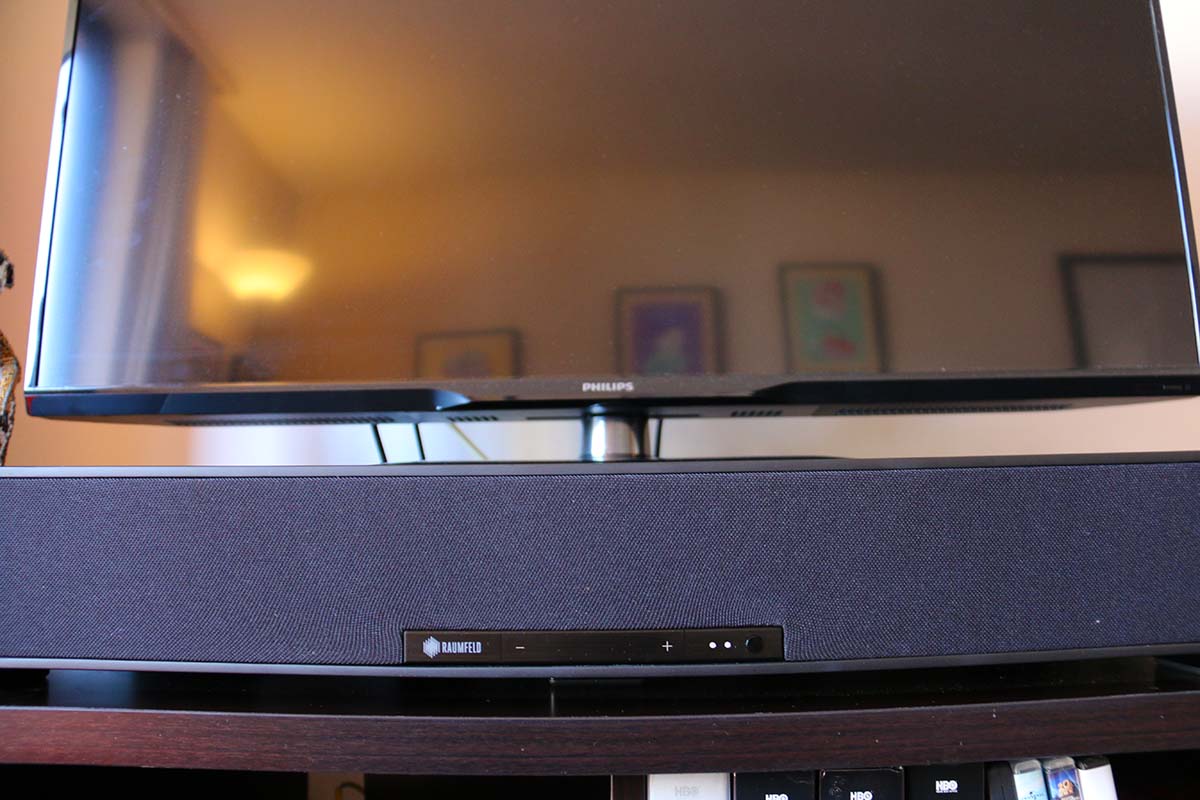
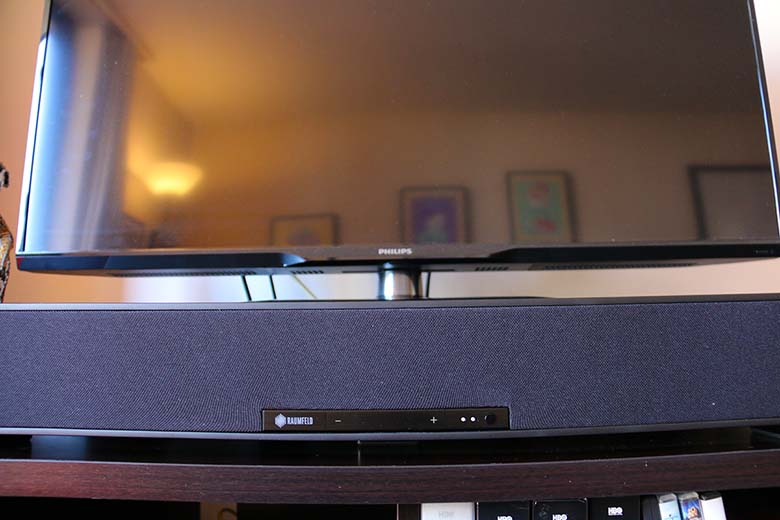
The Master Switch


The Master Switch
There’s something very aggressive about the Raumfeld Sounddeck. We’re not talking about the sound. We’re talking about the sheer aura that surrounds it, like a surly football player propping up a bar. Oh, you’re fine with that piddly little soundbar and accompanying micro-sub? You feel the need to dot tiny satellite speakers around your room so you can play at 5.1 or 7.1? OK, tough guy. You do that. But when you’re ready for some real muscle, when you want to put something the size of a shipping container under your TV and get some real sound, you come see me.
The Sounddeck - which is, as you’ve probably gathered, a rather large soundbase – has a hell of a lot of attitude, and costs a bundle. But is it worth it? Can the football player at the bar still run a few yards? Or is he nothing more than an armchair coach?
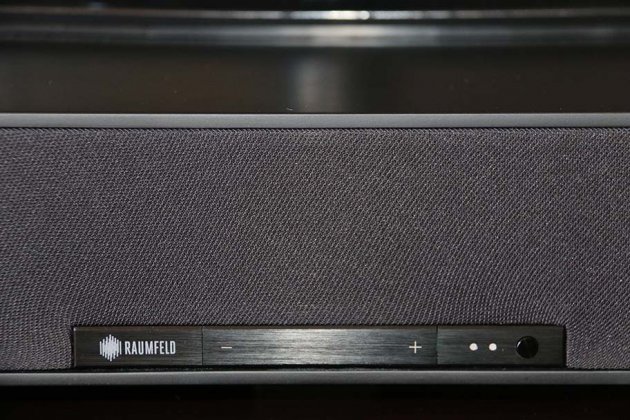
Perhaps the football player analogy isn’t appropriate. Perhaps a better one is the quiet gent you see sometimes at pubs in Herefordshire, England: the ones nursing a half-pint by themselves. For a long time, you won’t notice them. Your eyes will skate over them like they aren’t even there. But once you do see them, you can’t look away. Because Herefordshire is the home of the Special Air Service, the SAS, the single most effective fighting force on earth, and that quiet dude with his tiny drink could kick your ass six ways from Sunday.
Now that we’re done awkwardly comparing a piece of audio equipment to both a football player and a special forces operative, we can explain. The Sounddeck is able to blend effortlessly into the background, thanks to its uniform colour scheme and subtle controls. But once you notice it, you can’t stop looking at it.
For one thing, it’s big. Like, really big. Two and a half feet long, one and a half deep, four inches tall. And weighing at least 26.5 pounds! Traditionally, soundbases are given weight ratings, to indicate the maximum size of TV you can place on top. There is none here. You could drive a dump truck over the Sounddeck, and still have it pumping out noise. It’s an intimidating and formidable piece of kit.
We do like the design, though. The drivers are all hidden behind a mesh covering that extends and wraps around the sides, and the only controls are on a thin metal strip at the front. The ports around the back are all sensibly laid out and labelled, and the device is supported by four rubbery feet. It’s an unpretentious, gloriously simple design that works really well, in any type of room. Absolutely no problems here. We are also in love with the remote, which is a beautiful slab of brushed metal with sensibly placed buttons, favouring simplicity over everything.
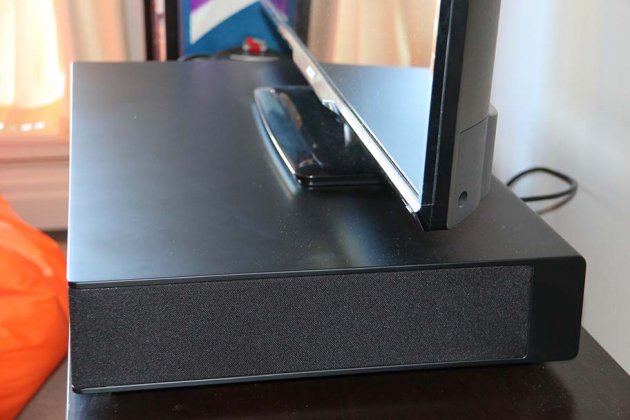
Normally we go straight onto sound quality, but we did encounter a few issues with setting up the Sounddeck.
You can connect to your TV in a variety of ways, including optical, analogue, and HDMI inputs. We opted for HDMI, and initially, got no sound at all. Ditto with optical, which we connected via a Playstation 4. Reconnecting a second time with HDMI had the desired effect, and we’re not sure what caused the glitch.
Raumfeld also offered a companion app, which (and we’re sorry to say this) was a pain to use. The app won’t even let you use any of its functions without running a connection test first, and just as with the HDMI problem, it took quite a while for us to perform the setup and connect the Deck to our Wifi. Once it was done, it was done, but we still try to avoid using the app wherever possible. Its design is functional, but uninspired, and unless we were playing a streaming service through the Deck, we came to the conclusion that it just wasn’t worth it.
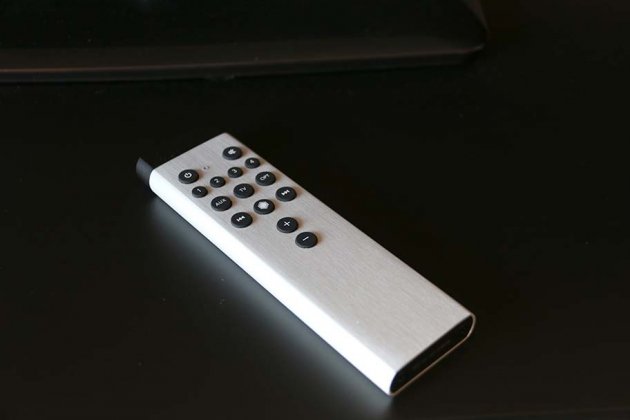
Things improved dramatically when we actually got to listen to what the Deck could do.
The advantage of soundbases is that they pack in enough tweeters, midrange drivers, and woofers to handle the entire frequency spectrum, without having to rely on multiple speaker sets. As all in one solutions, they are criminally underrated, and the Sounddeck made that clear immediately. A 280 watt amplifier powers six mid-range drivers along with two down firing woofers which, helped along by some very decent algorithms, manage to dish out some stellar audio.
Bass had proper weight and depth to it, with explosions and punches sounding suitably satisfying. We also loved the depth of the stereo field; Raumfeld make a big deal about their Wellenfeld acoustic technology, which just amounts to four distinct presets, but they’re still very good, allowing us to pick out a lot of detail and place distinct sounds in an environment. We got a real sense of this when we were playing an action game, and we could place the locations of our enemies using sound; very helpful when we were about to be shot in the head.
It did, however, let us down in a couple of areas. Dialogue never felt quite as clear as it could have been, especially at medium volumes. And although the unit is quite capable of streaming from Spotify or Tidal, as well as TuneIn Internet Radio, it’s just much better suited to movies and games than it is to music. It’s a bit like asking that football player to suddenly take up baseball. He could probably do it, maybe even do it well, but he’s never going to be as good as the other models.
There was also an annoying lag between changing the volume and the actual action occurring, which gave the base a slightly unresponsive feel. It always worked, and always picked up the remote, but it didn’t quite feel as immediate as it should have.
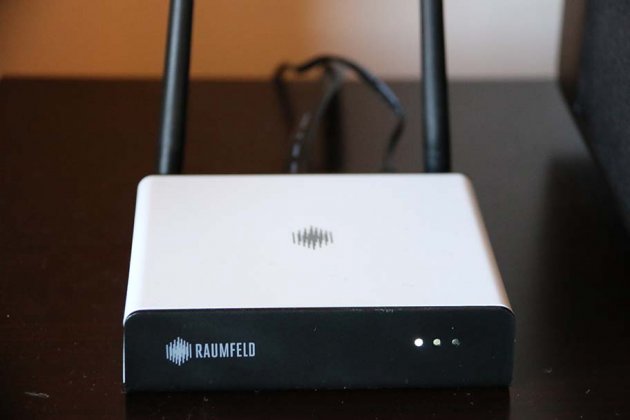
We also got a chance to test another Raumfeld product: the Expand, a dedicated WiFi router that creates a separate network in your home for your Raumfeld devices to connect to, theoretically relieving the strain on your existing network. While we don’t think it’s worth the full review by itself, it did mean we got to test it in conjunction with not one but two Raumfeld products (we reviewed the One-S speaker a couple of weeks ago).
Setup was relatively straightforward, and after we plugged it into our router, it quickly created a network. The problem is, we can’t say whether it relieved strain or not. Tests done with our existing network and with the one the Expand created were, as far as we could tell, identical, so it’s a little difficult for us to comment about the effectiveness of this one. But if you struggle with WiFi, or don’t get a good signal, then this could be worth investing in. At any rate, it’s a nifty idea, and one we’re glad to see Raumfeld using.
Here’s the kicker.
The Sounddeck is expensive. Four figure expensive. You’ll be paying around $1300 for it on Amazon. That puts a big question mark over whether or not it’s worth buying, when you could get competing products for much less, including a wireless 3.1 system from SONOS.
So this is the problem we have. On its own merits, this is a terrific product, with lots to recommend it, and plenty of reasons to buy it. It will fill any small-to-medium sized room with enough noise to wake the neighbours, and it (mostly) does what it advertises in an extremely effective way. But is it worth $1300? We’re not sure.
If you’re fed up with multiple components, and you want an all-in-one system that you’re sure is relatively future proof, then by all means, go for it. It’ll do you proud. But if you are even remotely cost conscious, then we can’t in good faith recommend you go for this one. It’s an absolutely phenomenal bit of kit, one we were happy to experience…but one we’re not sure is worth the asking price.
See the Raumfeld Sounddeck on Amazon
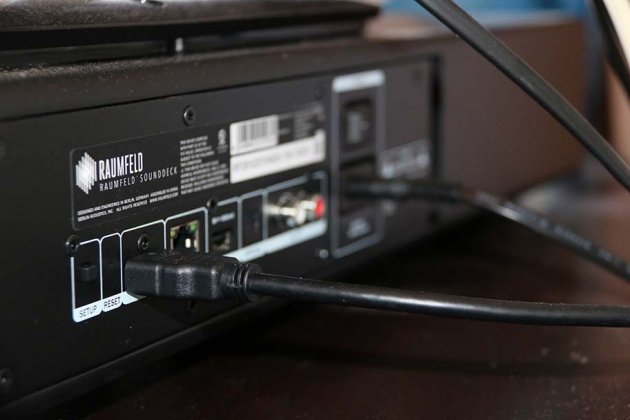
Great sound, excellent design, perfect all-in-one solution
Outrageously expensive
When you need a single audio solution, and don’t mind paying for it
Not a particularly well-known brand over here, and it doesn’t quite have the power of the Sounddeck, but at less than half the cost, it’s a very viable alternative.
This is one you go for when you want bass. Atlantic Technology use a patented Hybrid Pressure Acceleration System to really push out the low frequencies, increasing the argument for going for a base over a traditional subwoofer.
| Base | Price | Height | Footprint | Weight Rating* | Bluetooth | Wattage | Sub |
|---|---|---|---|---|---|---|---|
| Raumfeld Sounddeck | $1299 | 4.3" | 28.7" x 16.1" | Unknown | No | 100 | Yes - x2 |
| Canton DM55 | $550 | 2.7" | 21.5" x 11.8" | Unknown | Yes | 200 | Yes |
| Atlantic Tech. 3.1 HSB | $792 | 3.75" | 16.75" x 35.75" | 60" | Yes | 150 | Sort of... |